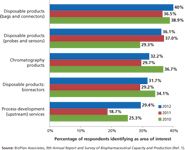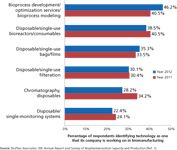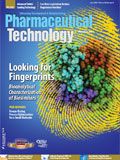Biomanufacturing Innovation
Industry wants more innovation, but can suppliers meet customer needs?
The biopharmaceutical industry has a voracious appetite for new technologies that increase productivity and improve performance, a point confirmed by BioPlan Associates' annual survey on bioprocessing trends and innovation (1).

Eric Langer
Bioprocessing innovations in demand
When asked about average budget changes from 2009–2012, those surveyed reported the highest budget increases were for new technologies to improve efficiencies and costs for downstream production (an average 6.4% increase) and for upstream production (an average 6.0% increase). For new products, the largest portion of respondents cited disposable bags and connectors (40.0%), followed by probes and sensors, (36.1%), chromatography products (32.2%), bioreactors (31.7%), and purification products (28.9%) (see Figure 1). Much of the interest in improved sensors, bioreactor, purification, and other equipment involves single-use applications. Only 10% of respondents wanted new stainless-steel equipment. In services, upstream process- development services topped the list.

Figure 1: Select new product and service areas of interest, 2010â2012.
The survey showed that a common cause for dissatisfaction with current single-use bioreactors, liners, and other equipment is they are not robust enough. Single-use equipment is still not adaptable to the more extreme mixing, heat, and other conditions involved with most microbial systems (e.g., E. coli and yeast).
When asked to rate the factors responsible for creating bioprocessing improvements in the past 12 months, the largest portion (72.6%) cited "overall better control of processes," followed by "improved downstream production operations," and "use of disposable/single-use devices."
Vendors' focus on R&D
To evaluate how well vendors' R&D match industry needs, the BioPlan survey asked about budget changes in 2012. Vendor respondents reported an average 1.9% increase in basic R&D for product development, a 2.4% increase for hiring new staff, a 4.3% gain in sales budgets, and a 3.4% uptick in capital-equipment purchases.
Survey data show vendors concentrating much of their R&D on improved and new single-use equipment (see Figure 2). The largest portion (46.2%) report working on bioprocess development/optimization services and bioprocess modeling, followed by disposable/single-use bioreactors and consumables, single-use bags and films, filtration, and chromatography products. Other examples of vendor R&D include: animal-free media components; bioreactor control; chromatography alternatives to Protein A; cell-line optimization; sensors and probes; culture-media optimization services; alternative mammalian-cell expression systems; monitoring systems; culture-media supplements; controller systems; impurities detection; bacterial expression systems; lyophilization; testing/assay services (e.g., raw materials, glycosylation, viral clearance, cell lines); and packaging materials.

Figure 2: The top six new technologies being worked on by vendors, 2010 â 2012.
Bioprocessing innovations trends
Several major trends have contributed to improved bioprocessing in the past decade. Legacy expression systems from the 1980–1990s, such as Chinese hamster ovary systems, yeasts, and E. coli have shown improvements in process yield (2). Mammalian-cell culture yields over 10 g/L are expected, and mammalian expression systems thoroughly dominate as classic microbial, including E. coli and yeast systems, are being displaced for in-house systems. Cell-line engineering and product-specific expression optimization are rather common in supporting higher yields and better product quality, particularly as off-patent high-yield cell lines go off patent and become more widely available.
Preclinical, clinical, and other precommercial manufacturing is dominated by single-use/disposable equipment Single-use equipment is on the verge of being adopted for commercial manufacture (3).
Major advances in sensors, automation, and process control have been made for improving quality control, such as single-use sensors and sensors for new analytes. Also, manufacturing systems can now be modeled, which facilitates process and facilities design and removes bottlenecks.
Eric Langer is president of BioPlan Associates, tel. 301.921.5979, elanger@bioplanassociates.com, and a periodic contributor to Outsourcing Outlook.
References
1. BioPlan Associates, 9th Annual Report and Survey of Biopharmaceutical Manufacturers (Rockville, MD, April 2012), www.bioplanassociates.com
2. BioPlan Associates, Biopharmaceutical Expression Systems (Rockville, MD, 2008).
3. Biotechnology Information Institute, www.biosimilars.com, accessed May 11, 2012.

Pharmaceutical Tariffs Are Imminent: How Industry is Bracing for Impact
April 16th 2025On April 14, 2025, the Trump Administration launched a national security-driven investigation into pharmaceuticals, a move that will likely result in tariffs being placed on pharmaceutical drugs, ingredients, and other components that are imported from outside of the United States.
Drug Solutions Podcast: A Closer Look at mRNA in Oncology and Vaccines
April 30th 2024In this episode fo the Drug Solutions Podcast, etherna’s vice-president of Technology and Innovation, Stefaan De Koker, discusses the merits and challenges of using mRNA as the foundation for therapeutics in oncology as well as for vaccines.